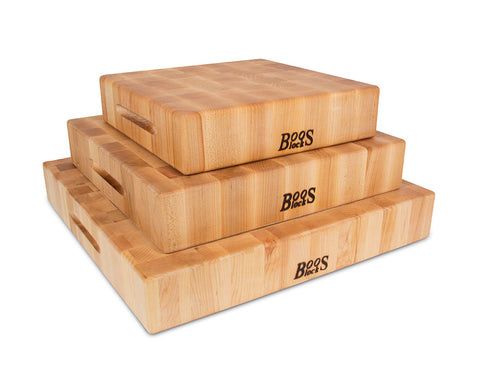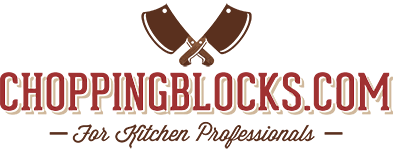Posted on February 25 2016

For as long as humans have brandished knives and heavy stone tools, we have required a cutting surface for them to be used. Wood, a naturally absorbent and forgiving material, made for an obvious choice from early days, and primitive log surfaces would have been a valuable work space for cutting and cleaning sharpened tools before industrialization.
Chopping blocks have been used in butcher shops for centuries, but long before they garnered their name, they were a utilitarian must-have for anyone working in the job of cutting meat on a large scale and even for those in the skilled trades of blacksmithing and masonry.
Even in the earliest incarnation of cutting tools, a knife that went dull would make for more work, so a safe and reliable work surface would have been sought out for multiple trades and work at home, or on the farm. The chopping block was born out of necessity and utility and remains a vital kitchen assistant to this day.
Though no date points to the first “chopping block”, it wasn’t until a more modern milling practice that the upright block on four legs would have arrived. Prior to a formal chopping block, kitchens, butcher houses used large and thick slices of wood as primitive cutting boards. The other main use of an upright block was the executioner's block. A shocking part of history about the beloved chopping block, but true. In fact, blocks are recorded in use in England from the 1400’s and often revolve around the use of the executions, with similar records around Europe during that time from neighboring royalty.
European settlers arrived at the United States en mass in the 1600’s. Early settlers would have come to the new world prepared with only the most basic provisions, intent on creating a life for themselves in uncharted territory. Hunting and slaughtering their own animals outside of the confines of a major city would have been a must from the get-go, so chopping blocks of various shapes and sizes may have made their entry into popular culture in the “west” (early Eastern colonization) at that point.
Wonderful hardwoods like maple, birch, cherry and black walnut would have been plentiful and made the perfect place to work with sharp or heavy tools, for immigrants to a new land.
Certainly the most primitive blocks, some of which can still be found for sale through antique dealers, were rounds of wood from a single tree that are seasoned and oiled. The largest problem with this rustic style of chopping block is the tendency for it to split over time along the natural grain. Any log exposed to the elements with weather and age, will often crack as it dries, so early rustic forms were secured with a leather strap, metal band or bolts to keep them intact.
In 1887, midwestern mill owner Conrad Boos cut a native sycamore to fashion a sturdy workspace for the local blacksmith. Not long after that block went into use, absorbing the weight of heavy blacksmithing tools, the local butcher noted the effectiveness of this piece and requested his own. Soon Boos' son John was creating "Boos butcher blocks" under the Boos company name for local small businesses within his operating region.
Before major transportation networks were created, different geographic regions in America were catered to by their own local trade specialists. Much as the Boos Company created blocks for their area within Illinois, other companies would have done the same around the country. Whether the Boos company can be given credit for the first “butcher block” is not known, but they have certainly kept good record of their discovery and continue to craft and sell blocks to this day.
For much of history since then, a chopping block was identified as a large square block, pressed and sealed from multiple shorter pieces of wood with the end grain exposed. Today we view chopping blocks as a semi-mobile workstation, but those of decades gone by would have been more permanent fixtures, lacking in wheels for moving and often mounted into a wall. In addition, almost any surface in a kitchen would have been covered in a thick sturdy wood, so that cutting and chopping could be done anywhere.
What’s the difference between the different types of blocks and why did modern kitchens switch to moveable blocks and cutting boards and away from butcher blocks that occupy a larger amount of real estate?
For starters, butcher block and free-standing tables are solid pieces of furniture, sometimes even solid pieces of wood harvested from one cut of tree and weighing on average 300 pounds or more. As modern houses took into account costs in building and sanitation practices, the cheaper and easier to move cutting board made its name.
Still, butcher blocks continued to be used in butcher shops and around heavy tools in non-cooking trades. However when industrial farming arrived in the mid 20th century, the way families ate changed as well. The grocery store and then supermarket replaced the neighborhood butcher and the way we process meat changed too. Mechanization of the meat trade meant that people were no longer handling meat in small batches, and the full size butcher blocks became unnecessary.
While smaller cutting boards have become all the more popular due to price and convenience, the classic chopping blocks are still highly coveted by chefs and kitchen cooks. Companies like John Boos and others have worked to create legacy items to be used in kitchens for generations. A chopping block passed down through a family shows its wear in its knife scars, dents and wear, but also adds a unique and romantic character to a kitchen work space. While they are certainly more rustic than a finished countertop, they are also a living history in your kitchen and well worth the space they occupy.
References
American Forests before European arrival
http://www.livescience.com/41198-old-growth-forests-before-europeans.html
John Boos & Co.
http://www.johnboos.com/history.asp

